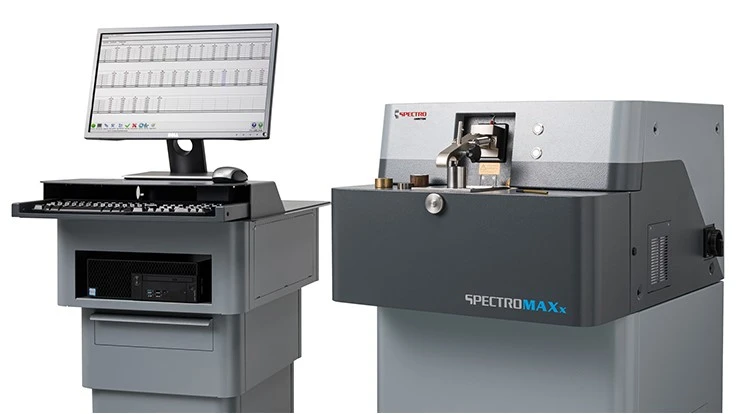
Photo courtesy of Spectro Analytical Instruments
Matching purchased scrap metal with the optimal melt shop buyer is a critical part of the path toward profits in the scrap recycling business. Identifying the chemistry of metal in hand is a key part of that wider process.
In an interview with Recycling Today last year, metals identification industry veteran Don Sackett, co-founder and CEO of SciAps Inc., said, “I’d say the next frontier is to make limits of detection lower and lower.”
The more narrowly a shipment of metal can meet desired specifications, the greater the likelihood a scrap processor can receive a premium for the product shipped.
Manufacturers of analyzing equipment have continued to introduce advances designed to offer buyers of their latest models an advantage in the competitive scrap market.
Earlier this year, Germany-based Spectro Analytical Instruments introduced the SpectroMaxx LMX10 arc/spark optical emission spectroscopy (OES) analyzer for what it calls fast, accurate, advanced elemental analysis in foundry, metal producing and related settings.
Spectro says if its new model, “The LMX10 has completely new factory calibrations; extended calibration ranges and element selections; optimized source excitation parameters; and improved limits of detection (LODs).”
Spectro says its new model contains “an added ultraviolet UV optic [that] handles a lower spectral range, from 120 nanometers to 235 nanometers.” The feature “includes a new capability to analyze oxygen in copper [and] analyzes relevant wavelengths to 766 nanometers, covering potassium,” the company adds.
Those capabilities tie into an observation by Sackett that in the energy sector, “The consumers [of pipes and oil and gas equipment] are pushing [such] limits onto the foundries. We’re hearing this for certain elements in nickel and copper alloys, too.”
Recyclers often use hand-held analyzers in scrap facility settings, versus larger arc/spark devices. On that front, SciAps, which is based in the U.S., has been emphasizing speed of readouts along with detailed measurements.
The company says its X-550 analyzer gun “sorts very similar grades of aluminum alloys in up to two seconds – as fast as stainless and high-temperature alloys.”
SciAps says the system’s X-ray technology measures magnesium and silicon as fast as it measures nickel, chromium, cobalt and other high-temperature metals.
Thermo Fisher Scientific, Waltham, Massachusetts, released its Niton XL5 Plus hand-held X-ray fluorescence (XRF) analyzer early last year, pointing to portability as a critical factor. It says its new model provides users with greater accessibility in hard-to-maneuver workspaces while reducing operator fatigue.
The company says it keeps the recycling environment in mind when designing its analyzers, according to Chloe Hansen-Toone, vice president with Thermo Fisher Niton. At the time the XL5 Plus was released, she said, “Inspection personnel tasked with material verification or contaminant detection are faced with constant pressure to provide quick and accurate analysis, a challenging task when considering the often harsh or remote environments that these professionals work in.”
Rigaku Analytical Devices, Wilmington, Massachusetts, says its Rigaku KT-100S hand-held laser-induced breakdown spectroscopy (LIBS) analyzer provides on-the-spot identification of difficult alloys, including aluminum grades, with lower detection limits and the ability to analyze more alloys than traditional hand-held identification methods.
Another major benefit to the user, according to Rigaku, is that the KT Series of hand-held LIBS analyzers use a laser excitation source, requiring minimal to no regulatory licensing (compared with some X-ray models).
Japan-based Olympus, which has a business unit dedicated to hand-held analyzers in Massachusetts in the U.S., says its Vanta Element-S hand-held XRF analyzer offers clear on-screen grade ID and comparison for the light elements magnesium, aluminum and silicon in seconds. Its silicon drift detector (SDD) can distinguish between similar alloy grades, such as 303 and 304 stainless steels, or aluminum 6061 or 6063 from 1100, according to Olympus.
As the metals-consuming energy and transportation sectors evolve at rapid rates in the 21st century, it seems likely the need for recyclers to pay close attention to metals chemistry will remain a priority.
Latest from Recycling Today
- ICM to host co-located events in Shanghai
- Astera runs into NIMBY concerns in Colorado
- ReMA opposes European efforts seeking export restrictions for recyclables
- Fresh Perspective: Raj Bagaria
- Saica announces plans for second US site
- Update: Novelis produces first aluminum coil made fully from recycled end-of-life automotive scrap
- Aimplas doubles online course offerings
- Radius to be acquired by Toyota subsidiary







